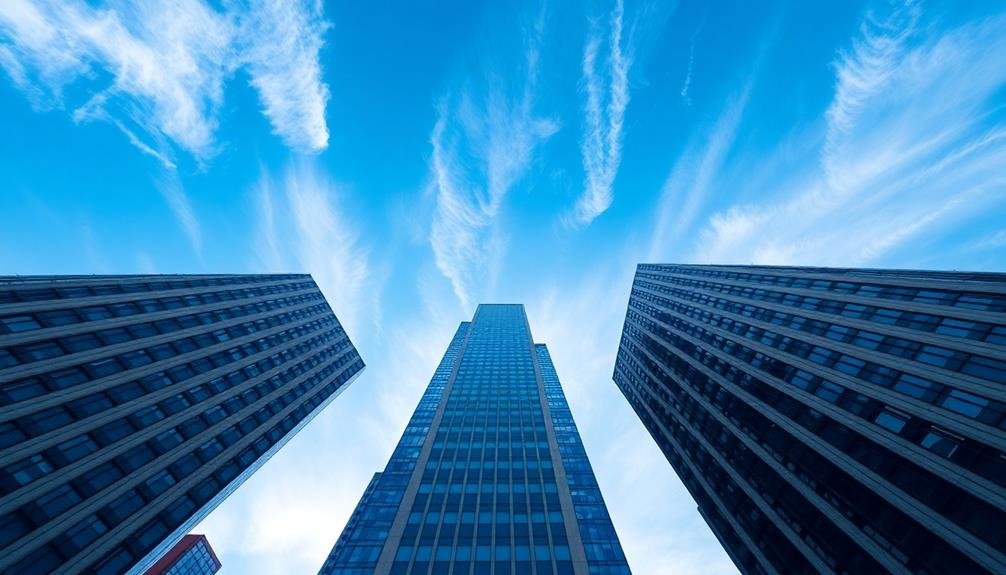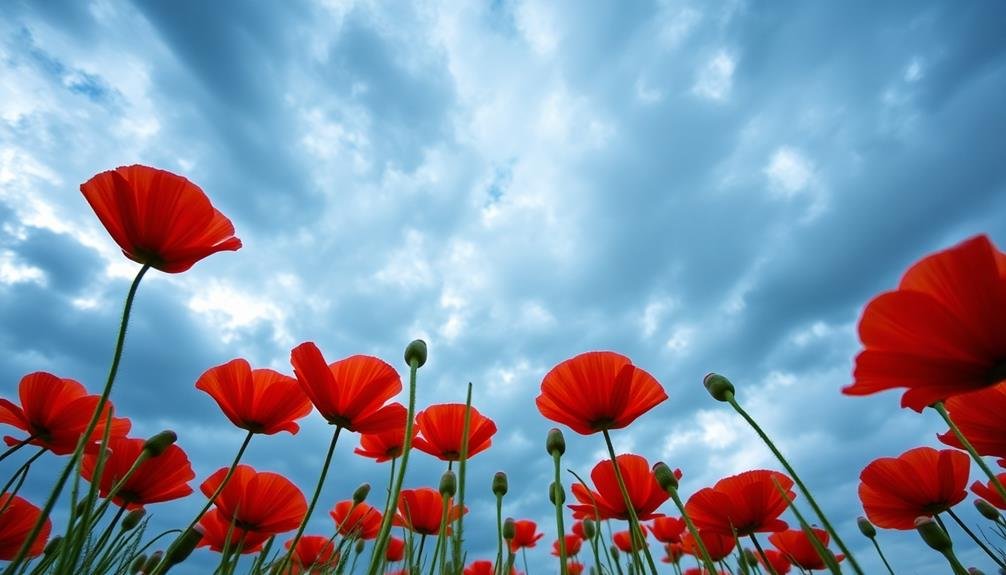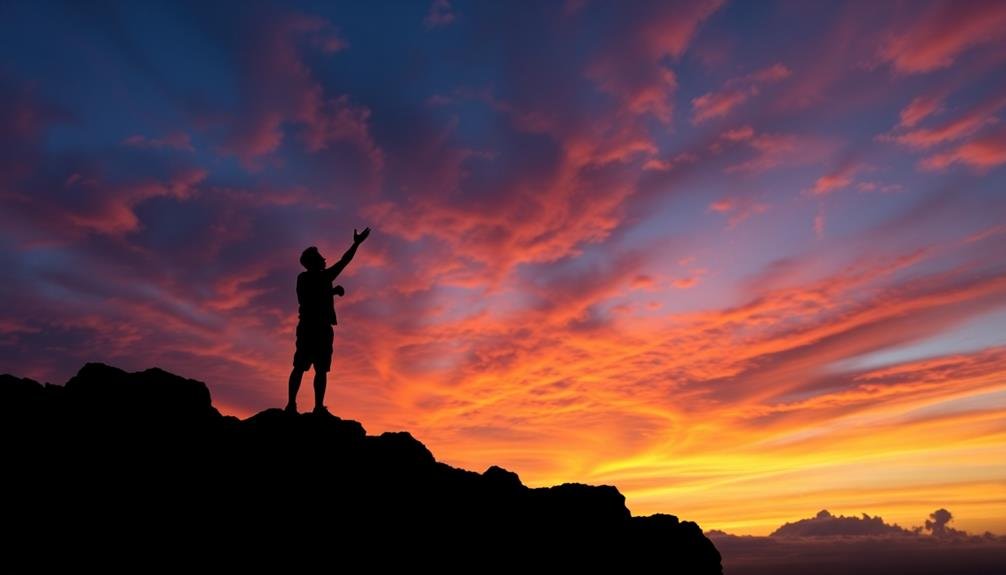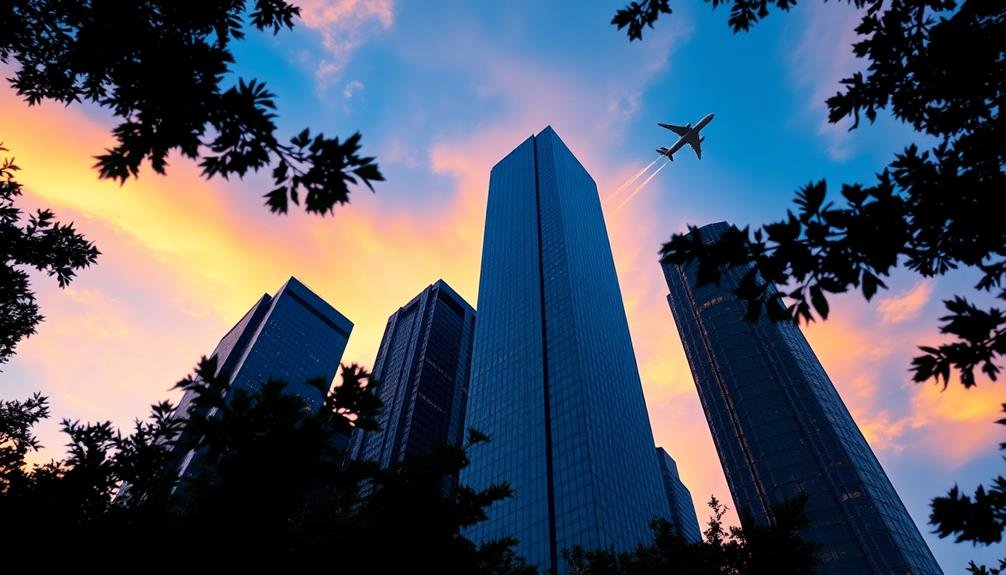To create stunning skyward shots, focus on foreground impact with these five tips. First, use leading lines to guide the viewer's eye upward, adding depth to your composition. Second, incorporate natural frames like arches or tree branches to provide context and dimension. Third, contrast colors and textures by juxtaposing soft clouds with rigid structures or vibrant hues against the sky. Fourth, play with scale and perspective by including recognizable objects or experimenting with different angles. Finally, emphasize interesting patterns in the sky through wide-angle lenses and strategic timing. Master these techniques, and you'll reveal a whole new world of enthralling skyward photography.
Key Takeaways
- Use leading lines in the foreground to guide the viewer's eye upward and create depth.
- Incorporate natural frames like trees or architecture to add context and dimension to skyward shots.
- Contrast foreground colors and textures with the sky to enhance visual impact and interest.
- Include recognizable objects in the foreground to provide a sense of scale and perspective.
- Emphasize interesting patterns in the sky by using wide-angle lenses and appropriate camera settings.
Utilize Leading Lines

Leading lines are a powerful tool in skyward photography. They guide the viewer's eye upward, creating depth and drawing attention to the sky. When shooting skyward, look for natural or man-made lines that point towards the heavens. Buildings, trees, or even contrails can serve as effective leading lines.
To use leading lines effectively, position yourself so that the lines start at the bottom of your frame and lead upwards. This creates a sense of movement and dimension in your image. You'll want to experiment with different angles and perspectives to find the most compelling composition.
Don't be afraid to get creative with your leading lines. Sometimes, unconventional elements like a winding staircase or a series of streetlights can create intriguing patterns that direct the eye skyward.
Remember to keep your lines straight and avoid distortion by using a wide-angle lens or adjusting your camera's position.
When incorporating leading lines, make certain they complement rather than overpower the sky. The goal is to enhance the overall composition, not distract from the main subject.
Incorporate Natural Frames

Natural frames can elevate your skyward shots from ordinary to extraordinary. When you're capturing the sky, look for elements in your surroundings that can create a frame around your subject. Trees, arches, windows, and even man-made structures can serve as compelling frames, drawing the viewer's eye to the sky while adding depth and context to your image.
To incorporate natural frames effectively, consider these techniques:
| Frame Type | Positioning | Effect |
|---|---|---|
| Tree branches | Edges of frame | Creates organic border |
| Architectural elements | Foreground | Adds geometric contrast |
| Rock formations | Bottom of frame | Grounds the image |
| Clouds | Top of frame | Softens composition |
Experiment with different frame sizes and shapes. A tight frame can create an intimate feel, while a wider frame can showcase more of the sky. Don't be afraid to get creative with asymmetrical or partial frames. Remember to adjust your exposure for the sky, as frames are often darker than the sky itself. By mastering the use of natural frames, you'll add a layer of visual interest to your skyward shots and create more engaging compositions that captivate viewers.
Contrast Colors and Textures

While framing sets the stage for your skyward shots, contrast in colors and textures can dramatically enhance their impact. Look for opportunities to juxtapose different elements within your composition. Pair the soft, billowing clouds with the rigid lines of a building or tree branches. Seek out vibrant colors that pop against the sky's backdrop, like a red kite soaring through a deep blue expanse.
Don't shy away from experimenting with different times of day. The golden hour can create warm, rich tones that contrast beautifully with cooler shades in the sky. During stormy weather, capture the interplay between dark, ominous clouds and patches of bright sunlight breaking through.
Consider texture as well. Rough tree bark, smooth glass skyscrapers, or the intricate patterns of leaves can all provide interesting contrasts to the sky's vastness.
Use your camera's settings to emphasize these textural differences. A wider aperture can create a soft, dreamy background while keeping foreground elements sharp and defined.
Play With Scale and Perspective

To create truly enchanting skyward shots, you'll need to play with scale and perspective. This technique adds depth and intrigue to your images, drawing viewers in and challenging their perceptions.
Start by including recognizable objects in the foreground, like trees, buildings, or people. These elements provide a sense of scale, making the sky appear even more vast and dramatic.
Experiment with different angles and viewpoints. Get low to the ground and shoot upwards to exaggerate the height of objects against the sky. Or, find a high vantage point and capture the world below, emphasizing the expansive sky above.
Use wide-angle lenses to distort perspective and create a sense of grandeur.
Don't shy away from including small details in your compositions. A bird in flight, a distant airplane, or even a tiny leaf can add interest and provide a contrasting scale to the enormous sky.
Remember to pay attention to the rule of thirds when composing your shots, placing key elements along the imaginary grid lines to create balance and visual appeal.
Emphasize Interesting Patterns

The sky is a canvas of ever-changing patterns, offering photographers endless opportunities for enchanting compositions. When shooting skyward, you'll want to emphasize these interesting patterns to create visually striking images. Look for repeating shapes, lines, or textures in clouds, tree branches, or architectural elements.
To capture these patterns effectively, you'll need to pay attention to your camera settings and composition techniques. Use a wide-angle lens to encompass more of the sky and experiment with different apertures to control depth of field. Consider using leading lines to guide the viewer's eye through the image and towards the pattern you're highlighting.
Here's a quick reference guide for capturing different types of sky patterns:
| Pattern Type | Best Time to Shoot | Camera Settings | Composition Tip |
|---|---|---|---|
| Cloud formations | Golden hour | f/8-f/11, ISO 100-400 | Rule of thirds |
| Star trails | Clear night | Long exposure, f/2.8-f/4 | Include foreground element |
| Sunbursts | Sunny day | f/16-f/22, fast shutter | Partially obscure sun |
| Light rays | Foggy morning | f/5.6-f/8, spot metering | Frame with objects |
Frequently Asked Questions
What Camera Settings Are Best for Capturing Skyward Shots?
For skyward shots, you'll want to use a wide aperture (f/2.8-f/4) to capture more light. Set your ISO low and adjust shutter speed for desired exposure. Use manual focus and a tripod for sharp images.
How Do I Protect My Camera When Shooting Directly Upwards?
When shooting upwards, protect your camera by using a lens hood to prevent glare and debris. You'll also want to cover the viewfinder to avoid light leaks. Don't forget to secure your camera strap tightly around your neck.
Are There Specific Weather Conditions That Enhance Skyward Photography?
You'll find that certain weather conditions can greatly enhance your skyward shots. Look for partly cloudy days with dramatic cloud formations, clear nights for stargazing, or even stormy skies for dramatic lightning photos. Don't forget golden hour lighting!
What Post-Processing Techniques Can Improve Skyward Images?
You can enhance your skyward images through post-processing techniques like adjusting contrast, boosting colors, and reducing noise. Don't forget to sharpen details, correct lens distortions, and experiment with HDR to bring out the sky's full potential.
How Can I Safely Photograph Skyward Shots in Urban Environments?
You'll want to prioritize safety when shooting skyward in urban areas. Watch your step, use a wide-angle lens to capture more without tilting back too far, and consider using a tripod for stability and comfort.
In Summary
You've now got the tools to create enchanting skyward shots with impactful foregrounds. Remember, it's all about balance and creativity. Don't be afraid to experiment with different angles, compositions, and subjects. As you practice these techniques, you'll develop your unique style. Keep looking up and exploring new ways to showcase the interplay between earth and sky. Your stunning images will inspire others to see the world from a fresh perspective.

As educators and advocates for responsible drone use, we’re committed to sharing our knowledge and expertise with aspiring aerial photographers.




Leave a Reply